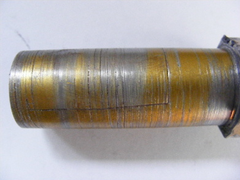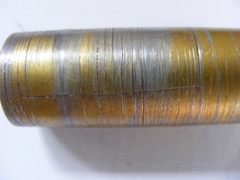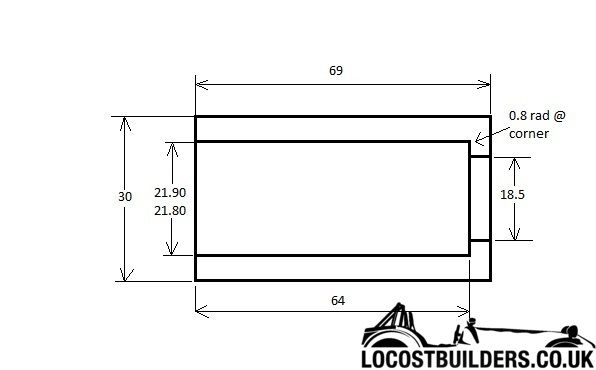alfas
|
| posted on 11/2/12 at 09:39 PM |

|
|
lets see things from another view:
how often you need to adjust the camber?
is it so difficult to take off the ball-joint for adjustment?
so the final question is: do i really need such an camber adjuster???
and do i really need to buy those cheapish china-made items at RD?
|
|
|
|
|
Chippy
|
| posted on 11/2/12 at 11:17 PM |

|
|
I have the alloy ones fitted, and did have to adjust the camber several times before landing on the correct, (for my car), degree of camber. Car has
done more than 6000 miles, most of which at a fair lick, especially on the twisty bits and no problems to date. Cheers Ray
To make a car go faster, just add lightness. Colin Chapman - OR - fit a bigger engine. Chippy
|
|
|
Hellfire
|
| posted on 13/2/12 at 12:51 PM |

|
|
quote:
Originally posted by alfas
lets see things from another view:
how often you need to adjust the camber?
is it so difficult to take off the ball-joint for adjustment?
so the final question is: do i really need such an camber adjuster???
and do i really need to buy those cheapish china-made items at RD?
The reason for fitting camber adjusters is to enable you to get accurate camber. It isn't particularly difficult to remove the balljoint but
without screwed camber adjusters, you are limited to adjustments of one full turn of the balljoint, which may not give you the desired camber for your
application.
It makes adjusting camber on trackdays much easier.
Whether you really need camber adjusters or not, is a question only you can answer...............
Having seen the aluminium ones fail, we will be replacing the ones we have with mild steel items. It's a small price to pay for 'peace of
mind' and I dread to think what the consequences would be if our aluminium adjusters should fail.
Phil

|
|
|
wylliezx9r
|
 posted on 13/2/12 at 01:11 PM posted on 13/2/12 at 01:11 PM |

|
|
I had a failure on my rear near side wishbone whilst exiting a round about, luckily I wasnt going to fast. The botom wishbone rose joint held on
luckily and the wheel didnt come off. I have since replaced all four with mild steel ones. It could have been a lot worse had the failure been on a
front wheel at speed etc. In my opinion aluminium ones shouldn't be for sale, they could easily end up killing somebody.
I spent a lot of money on booze, birds and fast cars. The rest I just squandered.
George Best
|
|
|
wylliezx9r
|
| posted on 13/2/12 at 01:26 PM |

|
|
These are the ones to get : Camber Adjusters Steel Front Top wishbone Kit Car Locost haynes roadster super 7 | eBay
[Edited on 13/2/12 by wylliezx9r]
I spent a lot of money on booze, birds and fast cars. The rest I just squandered.
George Best
|
|
|
Chippy
|
| posted on 13/2/12 at 05:09 PM |

|
|
quote:
Originally posted by wylliezx9r
These are the ones to get : Camber Adjusters Steel Front Top wishbone Kit Car Locost haynes roadster super 7 | eBay
[Edited on 13/2/12 by wylliezx9r]
Well despite the alloy ones having been OK for 6 Years, I have just bitten the bullet and purchased a pair of the above, better safe than sorry,   Cheers Ray
Cheers Ray
To make a car go faster, just add lightness. Colin Chapman - OR - fit a bigger engine. Chippy
|
|
|
sebastiaan
|
| posted on 13/2/12 at 05:42 PM |

|
|
Are these Flak's? (in the Ebay link) I'm sure most of us would rather buy from a fellow LB'er...
|
|
|
flak monkey
|
| posted on 13/2/12 at 05:54 PM |

|
|
Nope they arent mine.... no idea who is making them to be honest 
I can't do them for that price though....economies of scale n all that. So if someone else is offering them cheaper, that's that... there
wasnt anyone doing them in steel when I atarted making them.
Sera
http://www.motosera.com
|
|
|
Chippy
|
| posted on 16/2/12 at 03:49 PM |

|
|
Oooops
Well despite my post earlier, this is what I found when changing to the steel one from Ebay.
[img]
 
Adjuster crack1
[/img]
[img]
 
Adjuster crack2
[/img]
The crack can be clearly seem on the inside, but despite trying to take a picture it didn't show due to lack of light I guess. So be carefull
out there. Regards Ray
Plus foregot to add these are GTS ones.
[Edited on 16-2-12 by Chippy]
To make a car go faster, just add lightness. Colin Chapman - OR - fit a bigger engine. Chippy
|
|
|
AdrianH
|
| posted on 16/2/12 at 04:00 PM |

|
|
quote:
Originally posted by Chippy
Well despite my post earlier, this is what I found when changing to the steel one from Ebay.
 That looks as though there were cracks forming following the cut threads. You were wise to change them. After 6 years I guess any metal could
move around slightly within the tube and wear. That looks as though there were cracks forming following the cut threads. You were wise to change them. After 6 years I guess any metal could
move around slightly within the tube and wear.
Personally glad I don’t use any such things despite having no fine adjustment.
Adrian
Why do I have to make the tools to finish the job? More time then money.
|
|
|
ashg
|
| posted on 16/2/12 at 11:53 PM |

|
|
so thats 4 people now then!
sadly i think someone will need to have a big accident before the ali ones are withdrawn from sale.
on a plus note the steel ones i made 2 years ago after my ali ones failed have held up to thousands of miles over all types of surfaces.
Anything With Tits or Wheels Will cost you MONEY!!
Haynes Roadster (Finished)
Exocet (Finished & Sold)
New Project (Started)
|
|
|
flak monkey
|
| posted on 18/2/12 at 02:06 PM |

|
|
I would and do thoroughly recommend to anyone buying/using quick camber adjusters that they check them regularly for any early signs of problems
whether they are aluminium or steel. I would also only really recommend them for track use.
EN1A adjusters should be more than adequate for use on a sevenesque type car, but if they are subjected to any curb strikes do check them out.
The above pics of the aluminium ones dont really suprise me and I would urge anyone running those ones to check them out sooner rather than later.
I was recently told that the aluminium ones can also be quite a loose fit inside the wishbone tube, not a great idea as it means they have room to
move around and it makes the potential for problems much greater.
Obviously the choice of what you use on your own car is down to you.
I don't know of anyone who's using steel ones to have had a problem, and I know lots of people have made their own too having read about
the aluminium ones failing.
Sera
http://www.motosera.com
|
|
|
phelpsa
|
| posted on 18/2/12 at 02:20 PM |

|
|
The whole design (whether ali or steel) is compromised by that fact that you are taking both the preload and a the wishbone force through a series of
stress raising features.
I did some FEA investigation and decided that even in steel to be really safe I needed at least 3mm of material external to the thread OD with a cut
thread and a 0.8mm radius at head of the adjuster. In 6082 T6 ali you would ideally want a 2mm rad but you'd have to fatigue limit the thread.
That is assuming that the rod end doesn't reach the end of the adjuster (ie you're not using all the thread) which is quite normal in
these circumstances I believe.
I wouldn't be willing to publish the results (FEA is only as good as the numbers you put in obviously...) but those were the conclusions that I
drew.
EDIT: That was using a 5/8 UNF rod end rather than an M18x1.5 track rod end, but the results should be similar
[Edited on 18-2-12 by phelpsa]
[Edited on 18-2-12 by phelpsa]
|
|
|
Chippy
|
| posted on 18/2/12 at 03:20 PM |

|
|
quote:
Originally posted by phelpsa
That is assuming that the rod end doesn't reach the end of the adjuster (ie you're not using all the thread) which is quite normal in
these circumstances I believe.
[Edited on 18-2-12 by phelpsa]
Yes thats a true statement, the crack that you can see in the pictures that I posted above, where it turns to go round the adjuster is where the
thread ended, or almost. The other circular marks are not cracks but where the adjuster was screwed in causing the anodizing to be scored. Regards Ray
To make a car go faster, just add lightness. Colin Chapman - OR - fit a bigger engine. Chippy
|
|
|
britishtrident
|
| posted on 18/2/12 at 03:24 PM |

|
|
Woods and trees --- It is an adjuster not a nut , the is the part is being used incorrectly without a backing nut; ie a half nut
at one end and a Nyloc or Symonds nut at the other., You might get some fretting where the tube contacts the alloy but there is no chance of
catastrophic failure.
[I] “ What use our work, Bennet, if we cannot care for those we love? .”
― From BBC TV/Amazon's Ripper Street.
[/I]
|
|
|
phelpsa
|
| posted on 18/2/12 at 03:34 PM |

|
|
quote:
Originally posted by britishtrident
Woods and trees --- It is an adjuster not a nut , the is the part is being used incorrectly without a backing nut; ie a half nut
at one end and a Nyloc or Symonds nut at the other., You might get some fretting where the tube contacts the alloy but there is no chance of
catastrophic failure.
/\ BT in factual post shocker 
|
|
|
flak monkey
|
| posted on 20/2/12 at 07:04 PM |

|
|
Steel adjusters are approx 30% stronger than aluminium adjusters made from HE30/6082 T6 with a lower risk of fatigue failure.
But I would absolutely recommend that camber adjusters must fitted to a wishbone with a top tube similar to that shown in the attached image which has
a retaining lip at the outer end. This would safeguard the location of the top ball joint should the worst happen and an adjuster fail. And give some
warning without catastrophic failure as the adjuster nut would be loose on the inner end on inspection.
I really would emphasis that they should not be used on road vehicles and the top wishbone be of the more traditional design with a threaded tube as
supplied by most manufacturers.

Sera
http://www.motosera.com
|
|
|
Neville Jones
|
| posted on 21/2/12 at 10:31 AM |

|
|
quote:
Originally posted by britishtrident
Woods and trees --- It is an adjuster not a nut , the is the part is being used incorrectly without a backing nut; ie a half nut
at one end and a Nyloc or Symonds nut at the other., You might get some fretting where the tube contacts the alloy but there is no chance of
catastrophic failure.
Oh dear, we're thinking we are an engineer again, aren't we Mr.BT?
These 'adjusters', in the configuration intended, are essential and structural, and very much load bearing.
What happens if you take the sleeve out? You can't fit the balljoint. Sleeve is essential and structural.
What happens when not locked? the whole lot slaps around like a doodah in a street ladies money maker.
The safest solution is as Flak says, and do without the fine adjustment, and suffer the minute amount of camber different to the ideal you were
seeking. As if anyone here(myself included) would feel the difference. Well, unlees someone on here is an F1 or top Lm driver,
Cheers,
Nev.
|
|
|
mad-butcher
|
| posted on 22/2/12 at 05:12 PM |

|
|
I've just ordered a set off the above link
but if your looking to make your own these are great value for money eBay - The UK's Online Marketplace tubes are as
per above diagram tubes are as
per above diagram
[Edited on 22/2/12 by mad-butcher]
|
|
|
flak monkey
|
| posted on 22/2/12 at 07:55 PM |

|
|
Those are extremely good value. What you can achieve with CNC machines though 
And they have considered the issues I highlighted above.
Sera
http://www.motosera.com
|
|
|
mad-butcher
|
| posted on 22/2/12 at 08:17 PM |

|
|
spoke to a mate who does a bit of lathe work and he say's he couldn't even justify buying the material and switching the lights on at that
price just to make the tubes never mind the extra work making the adjusters
tony
|
|
|
flak monkey
|
| posted on 22/2/12 at 08:23 PM |

|
|
Yep, thats the thing. Making a set of just the inserts on a manual lathe, to reasonable accuracy takes around 20-30mins.
If you have an equipped workshop with OH's to pay as well (heating, lighting, rect etc), at £40-50/hr plus materials then its not possible to
make things for what people are willing to pay a lot of the time.
Making a set on a CNC machine would take less than 10 mins. If you have 2 then you could make the adjusters and tubes in the same time.
As Metallica once said, Sad but True...
Sera
http://www.motosera.com
|
|
|









